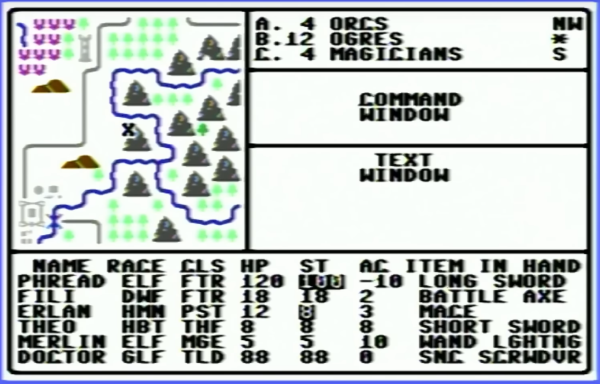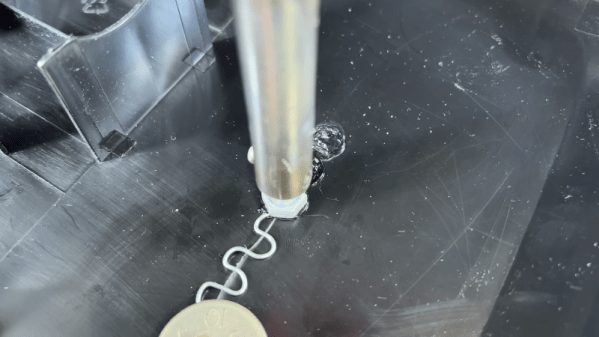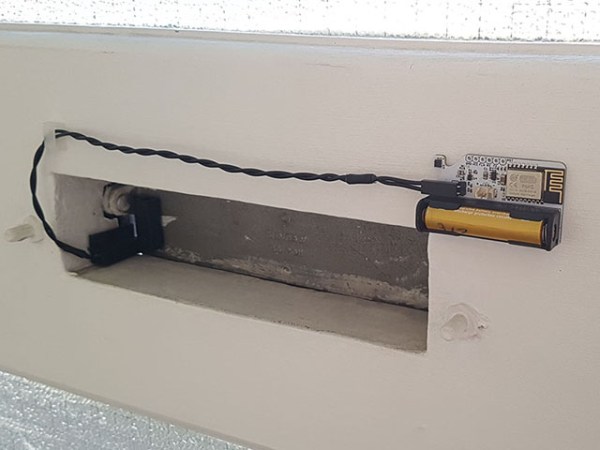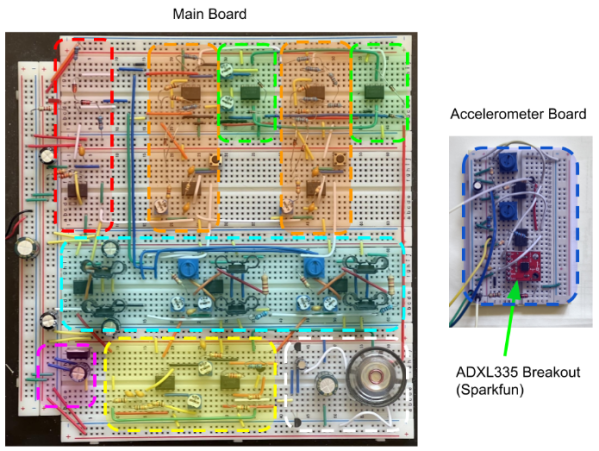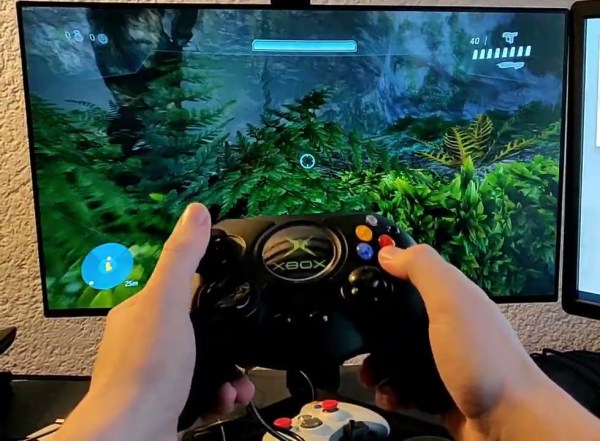GPS has changed the way we get around the globe. But if you command a warship, you must think about what you would do if an adversary destroyed or compromised your GPS system. The Royal Navy and Imperial College London think a quantum navigation system might be the answer.
Of course, Heisenberg says you can’t know your speed and position simultaneously. But at the real-world level, you can apparently get close enough. The quantum sensors in question are essentially accelerometers. Unlike conventional accelerometers, though, these devices use ultracold atoms to make very precise measurements using a laser optical ruler, which means they do not drift as rapidly as, say, the accelerometer in your phone. Navigating with accelerometers is well understood, but the issue is how often you have to correct your computed position with an actual reference due to drift and other error accumulation. You can see a Sky News report on the trial below. Continue reading “Royal Navy Tests Quantum Navigation”
Day: June 7, 2023
Well Documented Code Helps Revive Decades-Old Commodore Project
In the 1980s, [Mike] was working on his own RPG for the Commodore 64, inspired by dungeon crawlers of the era like Ultima IV and Telengard, both some of his favorites. The mechanics and gameplay were fairly revolutionary for the time, and [Mike] wanted to develop some of these ideas, especially the idea of line-of-sight, even further with his own game. But an illness, a stint in the military, and the rest of life since the 80s got in the way of finishing this project. This always nagged at him, so he finally dug out his decades-old project, dusted out his old Commodore and other antique equipment, and is hoping to finish it by 2024.
Luckily [Mike’s] younger self went to some extremes documenting the project, starting with a map he created which was inspired by Dungeons and Dragons. There are printed notes from a Commodore 64 printer, including all of the assembly instructions, augmented with his handwritten notes to explain how everything worked. He also has handwritten notes, including character set plans, disk sector use plans, menus, player commands, character stats, and equipment, all saved on paper. The early code was written using a machine language monitor since [Mike] didn’t know about the existence of assemblers at the time. Eventually, he discovered them and attempted to rebuild the code on a Commodore 128 and then an Amiga, but never got everything working together. There is some working code still on a floppy disk, but a lot of it doesn’t work together either.
While not quite finished yet, [Mike] has a well-thought-out plan for completing the build, involving aggregating all of the commented source code and doing quarterly sprints from here on out to attempt to get the project finished. We’re all excited to see how this project fares in the future. Beyond the huge scope of this pet project, we’d also suggest that this is an excellent example of thoroughly commenting one’s code to avoid having to solve mysteries or reinvent wheels when revisiting projects months (or decades) later. After all, self-documenting code doesn’t exist.
Continue reading “Well Documented Code Helps Revive Decades-Old Commodore Project”
Plastic Welding Revisited
Last time we talked about a video that purported to do plastic welding, we mentioned that the process wasn’t really plastic welding as we understood it. Judging by the comments, many people agreed, but it was still an interesting technique. Now [Inventor 101] has a video about plastic repair that also talks about welding, although — again, we aren’t sure all of the techniques qualify.
That’s not to say there aren’t some clever ideas, though. There are several variations on a theme, but the basic idea is to use a bolt or something similar in a soldering iron, metal reinforcement from things like wires and staples, and donor plastic from a zip tie. While we don’t think the nylon in a typical zip tie is the best way to repair anything other than nylon, if you were repairing something 3D printed, you could easily swap out the tie for filament of the same material, which — we think — would bond better.
Moving The Snail Mail To WiFi
[Zak] loves getting a notification on his phone when he gets physical mail. Enough to wire his mailbox slot with an ESP8285 to send him alerts. Previously, [Zak] used a cellular-based solution as the mailbox slot was not within WiFi range. However, the network provider for the A9G GPRS module decided to move to different towers, and suddenly the module didn’t work. Unable to find a provider that had sensible pricing, he got to work redesigning the module.
The mailbox was now in a WiFi network range, meaning he no longer had to use cellular. This dramatically simplifies the design and uses an ESP-M2 module (think ESP8266 but with embedded flash). To maximize battery life, the ESP is entirely off most of the time. A reed switch triggers a 74LVC1G98 NAND gate with an inverted input. This enables the 3.3 voltage regulator. A 4uF capacitor holds the voltage regulator on for 716ms, giving the ESP8266 time to boot and drive the second pin of the logic gate so it can stay on. Once the web request completes (a call to a PHP server that takes 4-5 seconds, including WiFi association), it pulls the pin low, and the system powers off. With a custom server, [Zak] can include a few goodies, such as temperature and humidity from the SHT32-DIS sensor.
So far, the system has been chugging along for seven months and over 110 mail notifications and has only dropped 0.3v, suggesting that the battery should hold out for another year or two before recharging. The code and schematics are up on GitHub. We love the low-power focus and the handy circuit explanation that makes it easy to use in other projects.
Op-Amp Challenge: Virtual Ball-in-a-Box Responds To Your Motions
With the incredible variety of projects submitted to our Op-Amp Contest, you’d almost forget that operational amplifiers were originally invented to perform mathematical operations, specifically inside analog computers. One popular “Hello World” kind of program for these computers is the “ball-in-a-box”, in which the computer simulates what happens when you drop a bouncy ball into a rigid box. [wlf647] has recreated this program using a handful of op amps and a classic display, and added a twist by making the system sensitive to gravity.
All the physics simulation work is performed by a set of TL072 JFET input op amps. Four are configured as integrators that simulate the motion of the ball in the X and Y directions, while four others serve as comparators that detect the ball’s collisions with the edges of the box and give it a push in the opposite direction. Three more op amps are connected to form a quadrature oscillator, which makes a set of sine and cosine waves that draw a circle representing the ball.
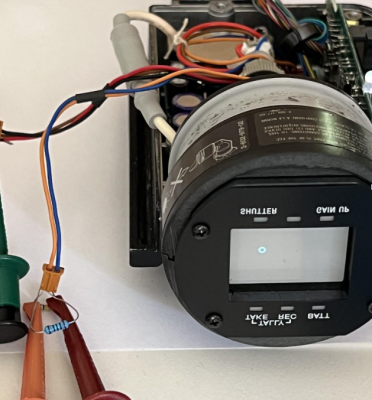 The simulator’s output signals are connected to a tiny viewfinder CRT as well as a speaker that makes a sound whenever the ball hits one of the screen’s edges. This makes for a great ball-in-box display already, but what really makes this build special is the addition of an analog MEMS accelerometer that modifies the gravity vector in the simulation.
The simulator’s output signals are connected to a tiny viewfinder CRT as well as a speaker that makes a sound whenever the ball hits one of the screen’s edges. This makes for a great ball-in-box display already, but what really makes this build special is the addition of an analog MEMS accelerometer that modifies the gravity vector in the simulation.
If you tilt or shake the sensor, the virtual box experiences a similar motion, which gives the simulation a beautiful live connection to the real world. You can see the result in a demo video [wlf647] recently posted.
The whole setup is currently sitting on a solderless breadboard, but [wlf647] is planning to integrate everything onto a PCB small enough to mount on the viewfinder, turning it into a self-contained motion simulator. Analog computers are perfect for this kind of work, and while they may seem old-fashioned, new ones are still being developed.
Books You Should Read: Prototype Nation
Over the years, I’ve been curious to dig deeper into the world of the manufacturing in China. But what I’ve found is that Western anecdotes often felt surface-level, distanced, literally and figuratively from the people living there. Like many hackers in the west, the allure of low-volume custom PCBs and mechanical prototypes has me enchanted. But the appeal of these places for their low costs and quick turnarounds makes me wonder: how is this possible? So I’m left wondering: who are the people and the forces at play that, combined, make the gears turn?
Enter Prototype Nation: China and the Contested Promise of Innovation, by Silvia Lindtner. Published in 2020, this book is the hallmark of ten years of research, five of which the author spent in Shenzhen recording field notes, conducting interviews, and participating in the startup and prototyping scene that the city offers.
This book digs deep into the forces at play, unraveling threads between politics, culture, and ripe circumstances to position China as a rising figure in global manufacturing. This book is a must-read for the manufacturing history we just lived through in the last decade and the intermingling relationship of the maker movement between the west and east.
Transform An Original Xbox Controller To A 360 Controller
If you’re looking for a controller for your computer or mobile device, you could certainly do worse than one of the latest iterations of the Xbox pad. They might not be perfect, but they’re fairly well-made, not particularly expensive, use standard USB and Bluetooth interfaces, and even have decent support in the open-source community. So if you’re gaming on Linux or working on any other kind of retro gaming rig it’ll likely be plug-and-play.
This wasn’t the case with the first generation Xbox controller, though, and although its proprietary connector was actually using USB, the controller scheme wasn’t as open. This is [Tom]’s effort of upcycling his original Xbox controller to work indistinguishably from a stock Xbox 360 controller.
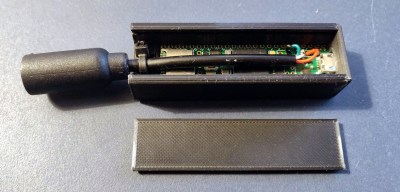 For those asking why anyone would want to do this, [Tom] is actually one of the few who enjoyed the original bulky Xbox “Duke” controller that released with the console in 2001. It wasn’t a popular choice in the larger gaming community and a year later Microsoft released a smaller version, but we all have our quirks. A Teensy 4.1 is attached to the end of the controller cable and acts as an intermediary to intercept the proprietary signalling coming from this controller and convert it into something usable. Since the controller doesn’t even show up as a standard USB HID device it took a little more sniffing of the protocol to decipher what was going on at all, but eventually some help was found within this other driver that gave [Tom] the clues he needed to get it working.
For those asking why anyone would want to do this, [Tom] is actually one of the few who enjoyed the original bulky Xbox “Duke” controller that released with the console in 2001. It wasn’t a popular choice in the larger gaming community and a year later Microsoft released a smaller version, but we all have our quirks. A Teensy 4.1 is attached to the end of the controller cable and acts as an intermediary to intercept the proprietary signalling coming from this controller and convert it into something usable. Since the controller doesn’t even show up as a standard USB HID device it took a little more sniffing of the protocol to decipher what was going on at all, but eventually some help was found within this other driver that gave [Tom] the clues he needed to get it working.
There were some other headaches to this project as well, especially since USB debugging USB connections while using USB isn’t exactly a streamlined process, but after a couple of breakthroughs the Teensy pass-through interface began working and [Tom] can use his controller of choice across multiple platforms now. If you’re looking to upgrade in other ways take a look at this build which seeks to recalibrate, rather than replace, an older Xbox controller experiencing drift on its analog control sticks.
Continue reading “Transform An Original Xbox Controller To A 360 Controller”


